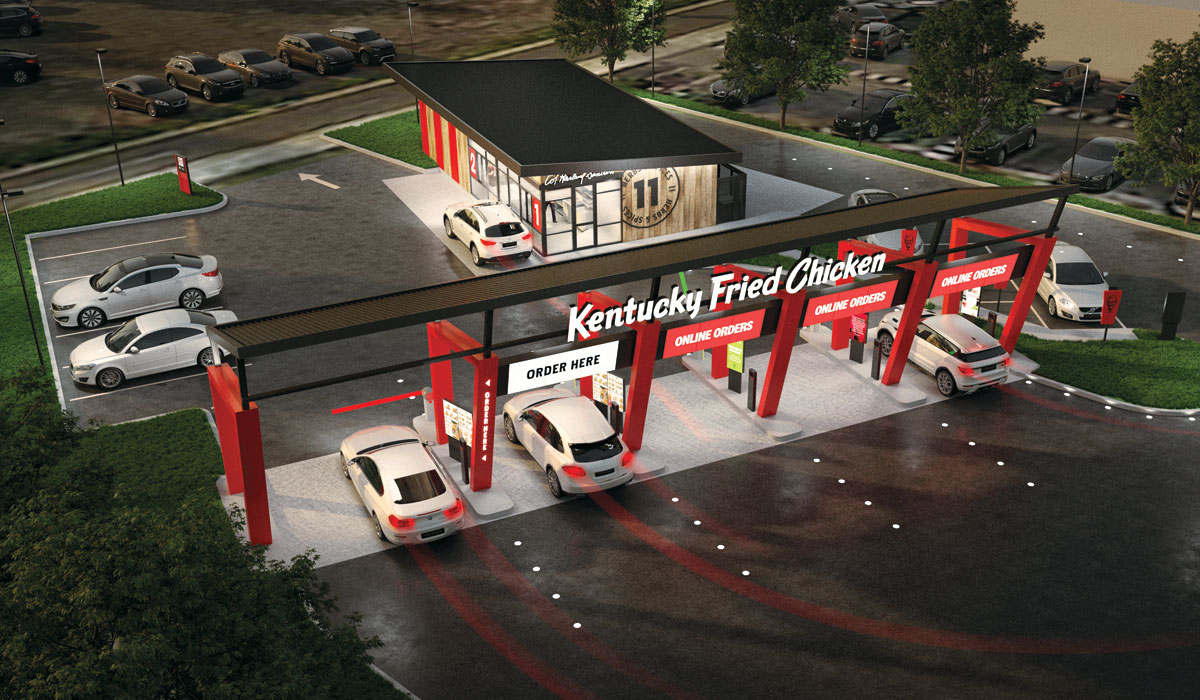As restaurants open back up for dine-in service, brands are scrambling to make stores feel as safe as possible, both for guests and employees. Many measures are being taken, like moving tables to create 6 feet of space between them, or adding barriers at ordering points. Most employees are wearing masks and gloves at all times, several stores are offering hand-sanitizer stations, and host stands are being moved outside. But all of these maneuvers, big and small, feel temporary.
The situation begs the question: What long-term effect will COVID-19 have on restaurant operations and design?
Some believe that guests, newly familiar with just how efficient off-premises ordering can be, will remain cautious of dining in for months, or even years, to come. Others suspect some customers may never return to dining rooms after becoming acquainted with the convenience of the now-ubiquitous off-premises ordering methods. Others still are convinced that the service changes being pushed to the fore will fundamentally alter the way restaurants are designed in the future.

Marty McCauley, design director at FRCH NELSON, a design firm based in Cincinnati, says tables won’t necessarily be permanently designed to be 6 or more feet apart, or have barriers between them. His firm has designed for Yum! Brands concepts including KFC units, as well as stores for other brands like Buffalo Rings & Wings and Domino’s. Based on his past experience with quick-serve design and the state of the industry today, McCauley believes quick-service brands will begin moving at least some of their portfolios toward small-footprint units geared toward facilitating off-premises transactions.
WHAT COULD THE RESTAURANT OF THE FUTURE LOOK LIKE? HERE ARE SOME POSSIBILITIES
“If we’re talking about designing restaurants from now on where there’s 6 feet of space between all tables, I view that as a knee-jerk reaction,” he says. “What’s not a knee-jerk reaction, [what] we really believe is the future of quick-service restaurants, is instead of these 3,000-square-foot units, you’re going to see maybe 1,500- or 2,000-square-foot units. What brands have learned is they have to have the ability to be agile, and customers are really responding to things like curbside pickup and other off-premises channels.”
McCauley says he isn’t suggesting that every quick serve built moving forward will clock in at 2,000 square feet or under, but rather that operators are experiencing firsthand how important it is to have some flexibility, both in a store’s build-out and also in the brand’s portfolio. Take Buffalo Wild Wings, for example, which unveiled its new fast-casual brand, Buffalo Wild Wings Go, in May with an 1,800-square-foot Atlanta prototype with limited seating. This foray into quick service was an admission of sorts: As other wing purveyors soared during the pandemic, Buffalo Wild Wings was left trying to figure out how to comply with social distancing and remain afloat.
“I can imagine moving forward that the commitment to flexibility will bring with it a range of expression,” McCauley says. “The idea isn’t that every building will get smaller, but that they have to create these pathways to go out and grab the attention of guests. More brands might try to-go-only concepts where they’re catching guests’ attention digitally rather than with signage outside of their storefront. Restaurants previously aimed to bring guests to them, but now they are having to figure out how to bring their brand to the guest.”
Still, delivery only makes up a portion of off-premises revenue, and firms like FRCH NELSON are helping clients figure out how to get more usage out of parking lots, with an emphasis on providing a branded experience from start to finish.
McCauley says that FRCH NELSON specializes in designing buildings where every single inch is scrutinized. While that’s always been an exciting challenge for McCauley and his team, he says the stakes have been raised in a world where the majority of guests never enter storefronts. If that continues into the future—and McCauley and his team think that it might—restaurant companies and their design firms will face the new challenge of creating branding out of the smallest outdoor details. These include signage, menuboards, pre-sell boards, drive-thru entry points, outdoor eating areas, and even pavement. Every element is a branding opportunity.
“We come from a place of strategy and insight where we are seeking to connect the brand and the product to the guest and their needs,” McCauley says. “Yes, at a certain point we’re just picking what type of material will make up the building’s facade, but even something like that we have to think about. What is it communicating to the guest? What are the touchpoints throughout the journey, and how do we guide and create tools of connection within the store’s design? When it all comes together—the brand, the product, and the environment—the end result is always supposed to connect with guests … and all of that is part of what we do.”
While no industry expert can say with certainty what store build-outs or customer behavior will look like in the future, it’s clear that off-premises will play a larger role in design than ever before. The pandemic has only accelerated what already felt inevitable pre-coronavirus. McCauley says there’s even some excitement over the direction this might lead the industry, and how storefronts will be designed in the future.
“Everything is on the table right now,” he says. “Everyone we talk to now is so heavily relying on the digital brand to forge their relationship, and you can feel that change we’ve been anticipating for a while; dining in has become less emphasized, and you must find ways to ensure that the digital relationship is still a branded experience that connects the guest to the product. It’s exciting for us, honestly.”












